
343 Fig, 305
343 CRYSTAL MODELS: Haiiy 1802-1804 (nil) Fig. 304, 305
Byjourny, Paris
Size about 40—80.
A set of beechwood models to show the crystalline habit of various minerals, obtained
through the good offices ofRené Juste Haiiy (1743-1822): Each model bears a paper
label on which is written in ink the name of the mineral and its form, e.g. “ chaux
fluat primitive” , “ chaux fluat emarginée” , “ chaux fluat triformé” . There are 521
models extant, and among these are a few, about six whole, and some broken,
showing Haiiy’s ideas of how a crystal may be considered to be built up of a series
of units, molecule intégrante. These latter include a model of dog-tooth spar and pyrite.
During the winter of 1798, Van Marum began to systematize his collection of
minerals, and on 9 December, 1799, he first wrote to Haiiy to try to obtain some
models, having seen the collection of Professor Burgmans at Leyden. Injanuary 1802,
Haiiy wrote to Van Marum telling him that the delay in sending: the models was
caused by the death of Pleuvin père. However, his work was being carried on by a
16-year-old named Journy, working with Pleuvin’s son. A whole set of models at this
time cost 355 livres (about £ 33), 10 sous being charged for a simple model, but
sometimes as much as 5 livres for a complex one, which could take as long as four
to five days to make. By December 1802, the price of a complete set had risen to
600 livres, the result of production problems in revolutionary France. Van Marum,
having seen Haiiy while visiting Paris in the summer of 1802, and subsequently
having received some models, paid to Pleuvin, on 24 September, the sum of 24 livres.
Between January 1803 and August 1804, there are extants bills showing that Van
Marum paid 387 livres for several parcels of models, totalling 508 in all.
The provision of crystal models may be considered an extension of the instrument-
maker’s art. They are an addition to the geometrical models that were common
throughout the 18th century (see Cat. 31). Euclidian models made of wood and
wire were sold in sets by George Adams Snr, and examples of these are in the Cambridge
and Oxford history of science museums. In the early 19th century, Lorkins sold boxes
of small, wooden geometrical and crystal models.
A brief account of Van Marum’s interest in crystallography and of his acquisition
of the models is in Nieuwenkamp (L & W iii 1971) 206-212. The correspondence
with Haiiy has been published by Hooykaas ( 1949). For ideas of crystal structure
and habit, see Haiiy (1784) and (1801HH
344 ARGAND LAMP 1784-1789 (213) Fig. 306
Possibly by W. Parker, London
Inscribed on paper shade: ARGAND’S PATENT
Overall height of reservoir, 385, base 130 x 130; height of lamp chimney 150,
diameter 43.
The lamp consists of an urn-shaped, brass, oil reservoir on a stand, to which the lamp
is attached by a bracket. The lamp has a glass chimney and a paper shade on a
zinc-plated wire frame. The Ebeling catalogue, lot 3 r 7, records an English brass lamp
after Argand, which Van Marum presumably acquired.
The inventor of this type of oil lamp was Aimé Argand (1750—1803) of Geneva, a
physician and chemist. He was granted a British patent (no. 1425) on 15 March, 1 784,
for a “ Lamp producing neither smoke nor smell, and giving more light than any
before known” . The novel feature of the lamp was the free circulation of air round,
and through the middle of, the circular wick, set in a perforated tube. This produced
a bright, hot, smoke-free flame. The lamp was also very economical on oil.